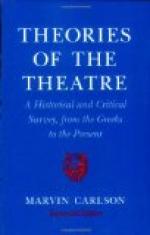The Intention of Permanence, whether it be conscious or subconscious with the artist, is a necessary factor of the noblest art. Many of us remember the Court of Honor at the World’s Columbian Exposition, at Chicago fifteen years ago. The sculpture was good and the architecture better. In chasteness and symmetry of general design, in spaciousness fittingly restrained, in simplicity more decorative than deliberate decoration, those white buildings blooming into gold and mirrored in a calm lagoon, dazzled the eye and delighted the aesthetic sense. And yet, merely because they lacked the Intention of Permanence, they failed to awaken that solemn happy heartache that we feel in looking upon the tumbled ruins of some ancient temple. We could never quite forget that the buildings of the Court of Honor were fabrics of frame and stucco sprayed with whitewash, and that the statues were kneaded out of plaster: they were set there for a year, not for all time. But there is at Paestum a crumbled Doric temple to Poseidon, built in ancient days to remind the reverent of that incalculable vastness that tosses men we know not whither. It stands forlorn in a malarious marsh, yet eternally within hearing of the unsubservient surge. Many of its massive stones have tottered to the earth; and irrelevant little birds sing in nests among the capitals and mock the solemn silence that the Greeks ordained. But the sacred Intention of Permanence that filled and thrilled the souls of those old builders stands triumphant over time; and if only a single devastated column stood to mark their meaning, it would yet be a greater thing than the entire Court of Honor, built only to commemorate the passing of a year.
In all the arts except the acted drama, it is easy even for the layman to distinguish work which is immediate and momentary from work which is permanent and real. It was the turbulent untutored crowd that clamored loudest in demanding that the Dewey Arch should be rendered permanent in marble: it was only the artists and the art-critics who were satisfied by the monument in its ephemeral state of frame and plaster. But in the drama, the layman often finds it difficult to distinguish between a piece intended merely for immediate entertainment and a piece that incorporates the Intention of Permanence. In particular he almost always fails to distinguish between what is really a character and what is merely an acting part. When a dramatist really creates a character, he imagines and projects a human being so truly conceived and so clearly presented that any average man would receive the impression of a living person if he were to read in manuscript the bare lines of the play. But when a playwright merely devises an acting part, he does nothing more than indicate to a capable actor the possibility of so comporting himself upon the stage as to convince his audience of humanity in his performance. From the standpoint of criticism, the main difficulty is that the actor’s art may




